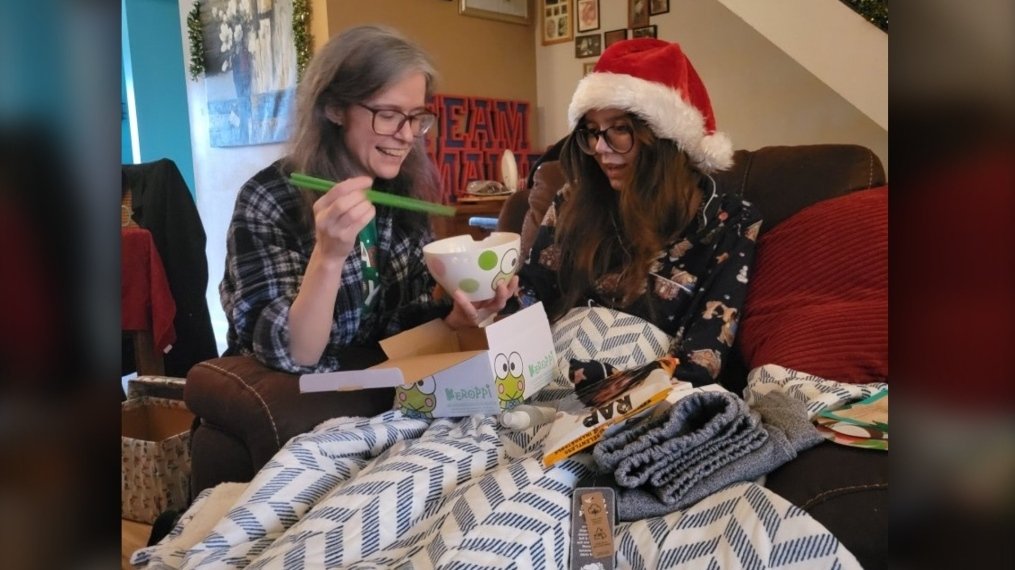A Canadian teenager is reaching audiences around the world with shocking social media videos showing life without hands and feet – the price she paid after developing sepsis.
“I think I want them to know that it’s more common than people think… that any type of infection can become septic,” said 19-year-old Amalie Henze.
The high school student in Brantford Ontario. She started feeling sick in October 2023. She initially thought it was related to Crohn’s disease, an inflammatory bowel disease (IBD) that causes the digestive tract to become swollen and irritated. But as Amalie worsened, she was rushed to A&E, with what she described as “an impending sense of doom” as she waited 18 hours to be admitted.
Her mother, Amanda Henze, says Amalie underwent tests, but it was only when staff lifted the sheets that they noticed her hands and feet had turned black – signs of severe sepsis.
“Oh, this is septic shock,” Amanda said in her interview with CTV News, recounting the reaction to her condition. “It has been overlooked, as if it were too late. “It was really scary.”
Sepsis occurs when a common infection caused by a bacteria, fungal infection, or virus (think flu) causes the immune system to overreact.
Amalie Henze before her amputation surgery. (Image courtesy of Amalie Henze)
In Amalie’s case, doctors later discovered a tear in her intestine that had allowed fecal matter to spill into her abdominal cavity, triggering the infection.
The result was a dangerous fight between the bacterial infection and the body’s immune response. If the immune system overreacts, it can damage the kidneys, liver, heart, and brain. The patient’s blood pressure may drop, depriving the tissues of blood and oxygen. Sepsis is a medical emergency.
To save Amalie, doctors put her in a coma to stabilize her blood pressure and maintain blood flow to her brain and vital organs.
The family waited for three terrible weeks.
“They were pretty clear that I probably wouldn’t make it,” Amanda said, wiping away a tear.
Fortunately, Amalie doesn’t remember the worst.
When he regained consciousness, doctors had to ask permission to amputate his blackened hands and feet. “I had to do it to save my life.” the teenager said.
 Amalie Henze is seen wearing one of the two prosthetic feet. (Image courtesy of Amalie Henze)
Amalie Henze is seen wearing one of the two prosthetic feet. (Image courtesy of Amalie Henze)
Find your audience
In her bedroom on the second floor of the family home, Amalie lifts her cell phone with her arms, which now start about four inches above where her wrists used to be.
He leans the phone against the furniture and begins to talk to his audience. He has nearly 50,000 followers and 3 million likes on TikTok. He just started on Instagram, where almost 20,000 more people see his stories.
A tragedy that could have silenced her has made her loud and proud to tell others about the risks of sepsis.
“This is my personal release… The Resurrection of Amalie Moira Henze,” she says in her first post about sepsis.
Dramatically, he pushes back his chair to reveal his severed limbs. “This is what septic shock does to you.”
His is a personal look at life without limbs. In a video, he shows how he puts on his foot prostheses. In another, he demonstrates how he uses his phone and iPad with what’s left of his arm to swipe and tap.
Her mother calls her inspirational.
“She gave me a hard time for not taking more pictures and documenting more of her rehabilitation (in the hospital)… (She) has to educate people on how this can happen,” Amanda said of her daughter.
Amalie says her messages are having an effect.
“I get comments on my videos saying they didn’t know what sepsis was, that they had an infection and got it tested, and they’re glad they did it before it progressed,” he said.
“It makes me feel like there’s a reason why all of this happened to me and it’s like turning a tragedy into something more beautiful,” Amalie added. “I don’t want other people to have to go through what happened to me.”
 Amalie Henze is seen with her mother, Amanda. (Image courtesy of Amalie Henze)
Amalie Henze is seen with her mother, Amanda. (Image courtesy of Amalie Henze)
“I think we don’t hear enough from young sepsis survivors about the impact on their lives and their health,” said Dr. Alison Fox Robichaud, critical care physician and chief scientific officer at Sepsis Canada. “I think Amalie’s message is very important.”
It is estimated that there are 75,000 cases of sepsis in Canada each year. That’s more than 200 people a day developing this medical emergency. About one in five does not survive.
Amalie spent almost four months in the hospital and in rehab before returning home. Sepsis, he admits, has changed everything about his and his family’s daily routine. The prosthetic legs are helping her walk again, but she still needs someone to be near her much of the day to help her eat and go to the bathroom. “A fully accessible bathroom is not very cheap, which is why I don’t have a fully accessible bathroom yet,” he said.
But first on his list are prosthetic hands to give him more independence. “You can put up to 30 different commands on it, so I can grab, pinch, point, open and close,” Amalie said. However, they cost $500,000. Some of it is covered by his father’s employment insurance, but the family is short about $120,000. Amalie is raising funds for the rest.
“There have been many difficult days for all of us,” his mother said. “Seeing her get stronger and really fight to be more independent is fantastic.”
Could this be sepsis?
Many people have never heard of sepsis or know what it can do. Some know it by an older term: “blood poisoning.”
Dr. Alison Fox-Robichaud says there are several signs that could indicate someone is developing sepsis.
“Uncontrolled shaking, confusion, not urinating, changes in skin color, blue or purple on your fingertips or knees,” are clues, Fox Robichaud said.
He has been on a decades-long campaign to have sepsis quickly recognized in hospitals across Canada. Unfortunately, there is no simple test, but rather requires the eye of a detective to determine where the infection may be lurking in the body.
This is because there are many common triggers, such as the flu, COVID, RSV, and even small skin wounds (like a paper cut) that become infected and can cause a septic reaction.
Those most at risk are children and the elderly, and those with chronic illnesses such as diabetes, arthritis, asthma and cancer, although it says anyone can be affected. Timely treatment helps, either by cleaning the wounds or with antibiotics. Vaccines, including those against bacterial pneumonia, can help prevent infections that cause sepsis, he says.
Fox-Robichaud agrees that it doesn’t hurt for patients to ask about this disorder if they or a family member is feeling seriously unwell.
“I think if people come to the door and say, ‘Could it be sepsis?’ That will make (healthcare workers) say, ‘Okay, maybe I need to see what organs are working and what organs are not working,’ he said, with subsequent testing to look for signs of low blood pressure, low oxygen saturation, and signs that the kidneys are failing.
Just weeks before Amalie’s hospitalization, a member of the UK Parliament, Craig MacKinlay, developed severe sepsis.
His wife Kati, a pharmacist, noticed his arms were cold and his blood pressure was dropping and insisted he be transported to a hospital where he was diagnosed and placed in a coma for 16 days.
Like Amalie, both legs and feet were amputated. He has now become a vocal advocate for sepsis awareness, telling Britain’s The Independent newspaper that he plans to push for faster diagnosis so that “the health service recognizes sepsis as soon as possible.”
Meanwhile, Amalie hopes to finish her high school diploma. His goal is a future in which he has new hands, a job and a home adapted to his disabilities. “My goal would be to get a house that was totally accessible, so I wouldn’t have to depend on anyone else. “I see a lot of other quadruple amputees who are able to do that, so it gives me hope for the future.”








